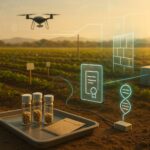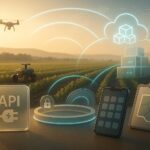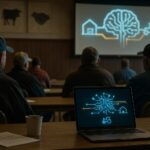When South Dakota Farmers Union gathers in Huron this December for its 110th state convention, the usual battles will be on the agenda: the farm bill, mandatory country-of-origin labelling, the fight against vertical integration and foreign ownership in the food system.
This year, something new is sitting alongside those long-running issues: artificial intelligence.
In a notice published on 16 November, South Dakota Farmers Union (SDFU) flagged a two-day convention on 10–11 December in Huron where “AI’s impact on production agriculture and alternative ways to think about complex global issues” will be discussed with family farmers, ranchers and a roster of invited national figures.
Speakers include National Farmers Union president Rob Larew, SDFU president Doug Sombke, macro-analyst Jacob Shapiro, technology thinker Peter Leyden and beef-sector and animal-health voices. The same meeting will set grassroots policy on mandatory country-of-origin labelling (MCOOL), the farm bill and special resolutions aimed at resisting further vertical integration and foreign ownership in the food system.
That mix of topics matters. It signals that in one of the most production-heavy corners of the United States, AI is no longer being treated as a side issue or a gadget. It is being folded into the core question that has animated farm politics for decades:
Who controls the levers of power in agriculture – and will AI reinforce that control or loosen it?
Table of Contents
ToggleAI arrives in an already concentrated farm economy
AI is arriving on farms at a moment when the structure of agriculture is already highly skewed towards large businesses.
- USDA data show that the number of farms in the United States fell to about 1.88 million in 2024, the lowest level in more than a century and roughly 8% fewer than in 2017.
- Around 86% of all US farms are “small family farms”, but they generate only 17% of total production value, according to a recent analysis of USDA data. Large-scale family farms (gross cash farm income of $1m or more) account for nearly half of production despite operating less than a third of the land.
Digital tools are following the same pattern:
- A US Government Accountability Office review estimated that 27% of US farms used some form of precision agriculture in 2023, with adoption rising sharply with farm size.
- On large crop farms, technologies such as yield monitors and soil maps now appear on roughly two-thirds of operations.
- Industry surveys suggest that by 2023, about 64% of US farmers were using some precision equipment, up from 49% in 2020.
Globally, the AI in agriculture market – everything from computer-vision crop scouting to predictive yield models and robotic harvesters – is estimated at $4.7bn in 2024, with some forecasters projecting annual growth rates above 25% into the 2030s.
In other words, AI is arriving in a sector where:
- economic power is already concentrated; and
- digital tools are being adopted fastest by the largest, best-capitalised farms.
For a grassroots organisation like SDFU, which explicitly defines its mission as defending family farmers and resisting further concentration, the question is not whether AI will be used in agriculture. It is who will set the conditions of that use.

A grassroots convention with digital questions baked in
The Huron convention will follow a familiar pattern. Delegates will gather to review and update SDFU’s policy line by line, vote on special orders and elect leadership. The current policy book commits the organisation to reinstating MCOOL, keeping the Supplemental Nutrition Assistance Program (SNAP) within the farm bill and resisting vertical integration and foreign ownership that could weaken the US food system.
This year’s agenda adds AI to the list of “uncertain times” concerns. The convention announcement notes that preparations were taking place against a backdrop of unstable crop and cattle markets, trade tensions and pressure to import more beef. Members, it says, are delaying input decisions for the 2026 season because market volatility makes long-term planning harder.
For SDFU, AI cuts across several of these longstanding issues:
- Market power and vertical integration.
If agronomic advice, credit scoring and risk management are increasingly mediated by black-box models owned by a handful of global firms, the fear is that bargaining power tilts even further away from family farmers. - Fair markets and transparency.
Label claims, carbon credits and sustainability premiums may increasingly rely on digital monitoring and verification. Who designs those systems – and who checks them – will shape who earns the value. - Right to repair and equipment control.
AI-enabled machinery, from planters to combines, depends on embedded software. Access to diagnostics and repair information is already contested terrain.
The SDFU meeting will not write national law. But its resolutions feed into National Farmers Union policy and broader coalitions, and they signal how organised farm groups intend to engage with AI rather than simply absorb whatever manufacturers and software vendors decide to offer.
Three big AI fights: data, repair and lock-in
Look across the current policy landscape, and three themes stand out as likely flashpoints in Huron and beyond.
1. Who owns – and uses – the data?
Digital platforms collect an expanding stream of information from farms: yield maps, soil samples, machine telemetry, satellite imagery, input decisions and even financial records. That data fuels AI models which, in turn, generate prescriptions, credit scores and risk profiles.
But legal frameworks for data ownership in agriculture remain patchy. Analysts describe agricultural data as a new arena for sovereignty struggles: decisions about who can access, process and monetise data from a farmer’s land go to the heart of control over production.
Internationally, farmer organisations are starting to respond. The World Farmers’ Organisation, for example, has adopted a policy on digitalisation and AI that calls explicitly for farmer-centred digital frameworks, where farmers retain meaningful control and benefit from data-driven value creation.
SDFU’s existing emphasis on fair markets and anti-concentration gives it a clear lens here. In Huron, the practical questions are likely to include:
- Should contracts for digital tools guarantee farmers access to their raw and processed data?
- How should data collected on South Dakota farms be stored, shared and governed?
- Should co-operatives or farmer-owned entities play a larger role in hosting platforms and negotiating digital terms?
These are not abstract concerns. They will influence whether small and medium-sized farms can use AI tools on their own terms, or whether they must accept take-it-or-leave-it conditions from much larger counterparties.
2. The right to repair in an AI age
The battle over who can fix farm machinery has already moved into legislatures and courts – and AI will only heighten the stakes.
- Colorado’s Consumer Right to Repair Agricultural Equipment Act, which came into force in 2024, obliges manufacturers to provide farmers and independent repair shops with the manuals, parts, software and tools needed to repair agricultural equipment.
- Several US states have passed broader right-to-repair laws for electronics, prompting manufacturers to change their service policies.
- At the federal level, the US Federal Trade Commission and multiple state attorneys-general have sued Deere & Co., alleging that the company’s software restrictions unlawfully monopolise repair services for its equipment.
As equipment becomes more automated, and as AI models help machines steer, plant and apply inputs, the practical line between “repairing hardware” and “modifying software” blurs. Manufacturers argue that tight control over software is necessary to ensure safety and emissions compliance. Farmers counter that without access to full diagnostics and repair tools, they become captive customers.
SDFU already lists “Right to Repair” among its legislative initiatives. Folding AI into that framework raises further questions:
- If a sprayer’s AI-driven application system fails mid-season, can a local technician fix it, or must the farm wait for an authorised dealer?
- Who bears liability if an AI update changes machine behaviour in the field?
- Should farmers have the right to inspect or audit the AI models embedded in their machinery?
The answers will shape not only repair bills but also downtime risk during tight planting and harvest windows.
3. Platform lock-in and vertical integration
Finally, there is the question of lock-in. Many of the most advanced digital tools in agriculture today – whether yield-prediction platforms, variable-rate recommendation engines or “whole-farm” management suites – are vertically integrated. Hardware, software, data storage and advisory services come as a package.
That model has real benefits: it lowers the barrier to entry and can deliver a smoother user experience. But it also creates switching costs and, potentially, gatekeepers that sit between farmers and markets.
US Government Accountability Office analysis notes that while precision agriculture improves efficiency and can boost yields, adoption is shaped by farm size, access to capital and concerns about vendor lock-in and data use.
SDFU’s existing policy priorities – keeping the farm bill current, protecting SNAP, pushing back against vertical integration and foreign ownership – are framed around economic resilience and sovereignty rather than digital technology per se.
As AI systems are layered on top of these existing platforms, the risk is straightforward: a small number of integrated providers could end up making, or at least heavily influencing, key agronomic and financial decisions for a large share of US production.
For an organisation built on the idea that “grassroots policy keeps farmers farming”, that is not just a technical choice. It is a constitutional one.
What farmer-centred AI could look like
The Huron convention is unlikely to produce detailed AI regulations. But it can sketch out principles that will guide how SDFU engages with technology providers, regulators and national farm organisations over the next decade.
Based on current debates in South Dakota and internationally, a farmer-centred AI agenda might include:
- Clear data rights.
Contracts that spell out who owns which data, who can monetise it and how farmers can move their data between providers. - Interoperability and open standards.
Support for common data formats and interfaces so that farmers can plug different tools together and avoid being locked into a single ecosystem. - Robust right-to-repair.
Legal guarantees that farmers and independent technicians can diagnose and fix AI-enabled equipment without voiding warranties, subject to reasonable safety constraints. - Collective bargaining power.
Co-operatives and farmer organisations negotiating digital terms, not just commodity prices. - Transparency and auditability.
Mechanisms for checking how AI models make recommendations, especially when those models affect access to credit, insurance or government programmes.
The World Farmers’ Organisation’s recent push at the World Trade Organization for “farmer-centred digital frameworks” points in the same direction: treat farmers not as data sources, but as co-designers and co-owners of digital value chains.
Why it matters beyond South Dakota
It would be easy to dismiss a state-level convention in a town of fewer than 15,000 people as a local story. That would be a mistake.
South Dakota is a significant producer of corn, soybeans, wheat and beef. Its farmers are early adopters of many precision tools. Its union is influential in national debates through National Farmers Union and wider coalitions on right-to-repair, biofuels and cattle market reform.
The questions being raised in Huron in December – about data, repair, concentration and control – are the same ones that will shape AI adoption in agriculture from Iowa to India, and from Brazil’s Cerrado to the North China Plain. The technologies are global. The governance, for now, is local and fragmented.
SDFU’s decision to put AI on the same agenda as MCOOL and the farm bill is therefore a signal. It suggests that, at least in some corners of US agriculture, AI is no longer being treated as a futuristic add-on to be left to engineers and product managers. It is being treated as infrastructure – and infrastructure has politics.
For AgTech companies and investors, that has a simple implication: the next wave of innovation will not be judged only on yields, efficiency and growth rates. It will also be judged on how power is distributed – between farmers and platforms, between local communities and distant balance sheets.
In Huron this December, family farmers will begin to write their own answer to that question.




